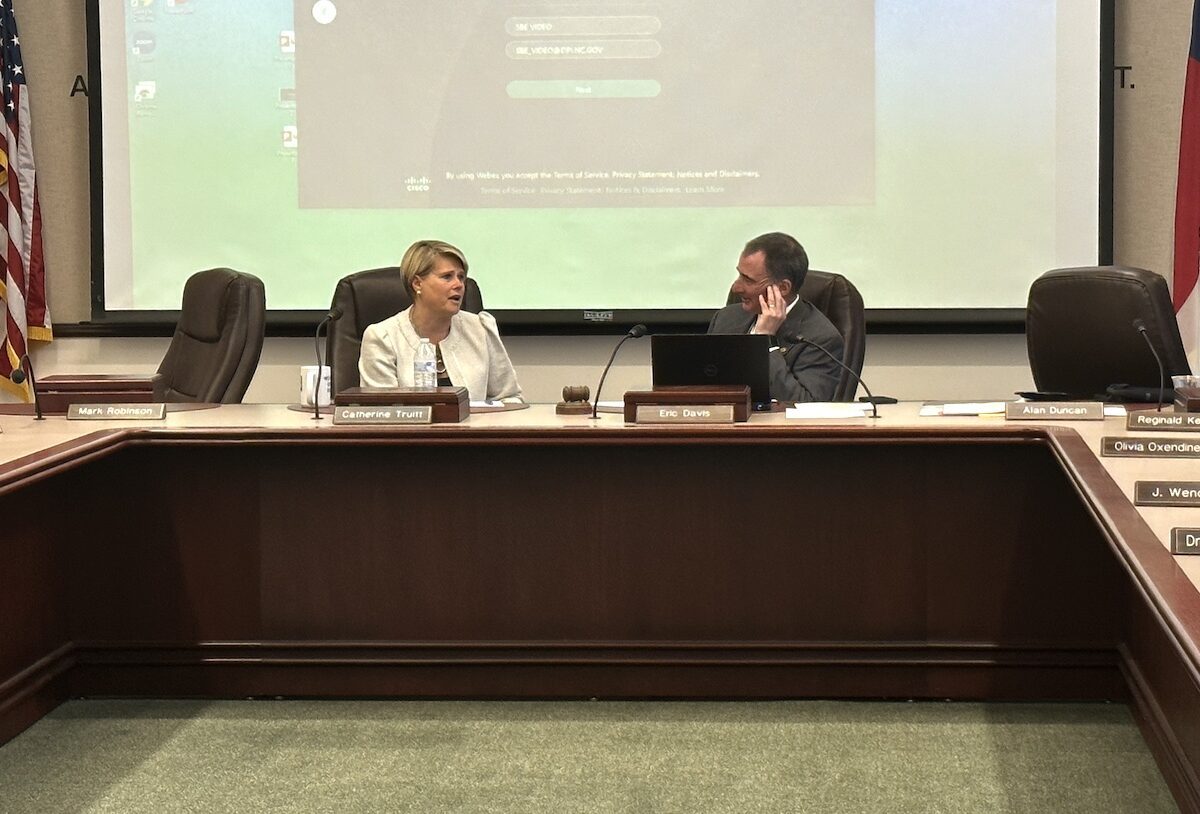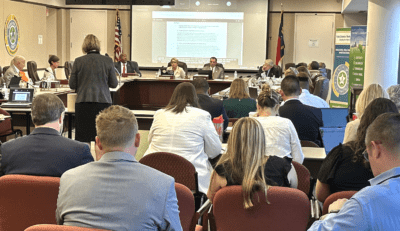
|
|
Educators have a lot of questions about how to comply with the Parents’ Bill of Rights, enacted just a few weeks ago. The Department of Public Instruction (DPI) is now trying to get them more information and time before it goes into effect.
The law, which limits certain instruction around LGBTQ+ and sexuality in kindergarten through fourth grade and mandates certain parent notifications, is scheduled to take effect in schools on Sept. 15.
State Superintendent Catherine Truitt told the State Board of Education on Thursday that she has asked legislators for an extension until Jan. 1. Truitt said some of the provisions require DPI to present for Board approval, and that requires time.
“I feel very good about the conversations we’ve had with legislators,” Truitt said. “They are listening to us and recognize there’s not enough time for districts to get these things in place.”
Truitt hopes an extension will be included when the General Assembly releases its budget, which is expected next week.
Truitt is also asking for clarity on how a biannual student survey can be administered. The law requires parent permission for certain student surveys. Among the surveys impacted is the Youth Risk Behavior Survey (YRBS), which DPI staff have said is the only one of its kind to provide direct feedback from students on their mental health.
Historically, families are able to opt out when their students are selected for this survey. Under the Parents’ Bill of Rights law, families would have to opt in for the survey. Truitt said that could reduce participation rates.
“We don’t want to make this harder than it needs to be,” Truitt said. “I feel very confident about the conversations that I’m having with the legislature about the need for this particular carve-out.”
The State Board of Education this week also enacted a policy on charter school funding and reviewed student test scores and school performance grades from the previous school year. Keep reading for more.
School performance grades
State test results from the 2022-23 school year showed slight progress according to North Carolina’s accountability measures, but proficiency remains below the state’s goals.
The data, presented to the State Board of Education on Wednesday, showed that more than 70% of schools met or exceeded their goals for academic growth. The proportion of schools that did not meet growth expectations was just 1 percentage point higher than in the most recent pre-pandemic year of 2018-19.
Tammy Howard, senior director of accountability and testing for the DPI, cautioned that the impacts of pandemic disruptions persist in the data.
“We have to always remember very clearly that we are still in pandemic environment and the impact that it’s had on teachers and the community at large,” she said.
State Superintendent Catherine Truitt said last year’s accountability results show that schools remain on track to recover from the significant setbacks caused by COVID-19.
“It’s hard to overstate the impact of the pandemic,” she said, “but teachers across North Carolina are working harder than ever to help students recover, and more importantly, advance in their learning. We owe them our gratitude for meeting this challenge to improve outcomes for students.”
Truitt noted that the 2022-23 data represents a second consecutive year of gains.
“Students and schools still have a way to go to catch up, but we have good reason to think that progress will continue,” she said.
You can find more information below.
The accountability report presented this week features all elements of the state’s accountability framework, including the calculation of growth designations and A-F school performance grades. Student performance on the state tests make up 80% of a school’s grade, whereas student growth is weighted 20%.

More than one in four of the state’s nearly 2,600 public schools earned a school performance grade of an A or B. Nearly two out of every three earned a C or better.

Results for the 2022-23 year show strong gains, particularly in math, with pandemic losses in some grades cut by more than two thirds, according to a press release from DPI. Reading scores also improved in all grades, with losses from 2020-21 cut by half, or more, in some grades.
The number of schools designated as low performing decreased from 864 to 804 in 2022-23, but this is still higher than the 488 identified before the pandemic in 2018-19.
Low-performing districts are districts where the majority of schools received a performance grade and have been identified as low performing, according to DPI. The number of low-performing districts for 2022-23 decreased to 25 from 29 the year before.
Board chair Eric Davis emphasized that the results reflect the dedication of many educators and students.
“There is clear evidence of the efforts of educators, students, and parents to close the gaps in academic learning created during the pandemic,” Davis said. “We should recognize those efforts and support those efforts with the resources our students need to succeed.”
Dive deeper into the data
EdNC will be releasing our maps of school letter grades later this fall so you can adjust the formula based on your values and see the impact on the school grades. We created the mapping tool to build awareness about how public policy choices — like the 80%, 20% formula — impact the perception of schools.
Meanwhile, here are some links to helpful resources on the data:
- Here is the DPI’s webpage with all of the information about the school performance grades.
- Here is DPI’s press release.
- Here are the 2022-23 school performance grades.
- Here are the 2022-23 low-performing designations.
- Here is the accountability framework background brief.
- Here is the presentation for the communication webinar.
- Here is the report.
Next phase for NC Check-Ins
DPI is working with statewide partners to implement the next version of North Carolina Check-Ins, a testing strategy that state leaders hope will provide teachers, students, and families with information about student performance on grade-level content standards throughout the year.
N.C. Check-Ins is the result of a Task Force on Summative Assessment that began in 2015. At that time, one of the critiques offered by the task force was that traditional end-of-grade and end-of-course testing gives feedback to stakeholders after instruction is completed. That doesn’t help teachers identify and respond to instruction gaps for students. The check-ins are a series of three tests given throughout the year and would replace the EOGs.
Some districts started piloting check-ins in 2015 and, in 2019, the U.S. Department of Education gave the state an Innovative Assessment Demonstration Authority (IADA). Also in 2019, the General Assembly passed a law moving “toward a through-grade assessment model, in which the State-mandated assessments are administered in multiple short testing events throughout the school year rather than a single long testing event at the end of the year.”
Through that work, DPI is piloting the North Carolina Personalized Assessment Test (NCPAT) system, which is an expanded model of check-ins. Previously, students randomly received one of three versions of an EOG. Under the expanded model, or N.C. Check-Ins 2.0, student performance on the two interim check-ins throughout the year would inform which of three flexible summative forms students take at the end of the year.
DPI said the through-grade assessments provide immediate, formative feedback data to support instruction. The feedback comes through online reporting to teachers the day after each check-in. The interim results are not used for accountability, only the final test.
This is the start of the fifth year of the pilot. Last year, schools participating in the NCPAT pilot administered N.C. Check-Ins 2.0 for math and reading to eligible students in grades four, five, seven, and eight, and the flexible summative for reading and math at grades four and seven.
The Board will hear an update next month, which would include a plan to scale the pilot statewide this year.
Remediation for college-bound high school students
The Board heard feedback on the College and Career Ready Graduates (CCRG) program, which is the state’s attempt at addressing the long-standing challenges of supporting students who enroll in community colleges unprepared in English or math.
When students graduate secondary school and have to enroll in remedial classes for college, it costs both time and money – creating a barrier to postsecondary completion. A 2015 Hunt Institute report estimated the annual cost of remediation, or developmental education, at $125 million in 2012.
In 2015, former state senator Chad Barefoot, who saw a relative navigate the experience of math remediation after enrolling at Wake Technical Community College, sponsored the bill that would eventually establish CCRG in 2016.
CCRG is a partnership between the public school and community college systems that would offer remediation to high school seniors so they can catch up in English and math before enrolling in college. After laying the groundwork through pilots and statewide training, implementation was interrupted by COVID-19 in 2020 and again in 2021-22 due to lack of funding.
Last year, the General Assembly funded the program for the first time, and the state began its first full year of implementation. The community college system decided to use the NROC EdReady software to provide these courses to high school students.
Note: NROC is the same software the community college used for its most recent attempt to address remediation. That attempt, RISE, was a corequisite model. It was abandoned in 2021. You can read EdNC’s coverage of RISE and the challenges of remediation.
On Wednesday, Tammy Howard, DPI’s senior director for the Office of Accountability and Testing, presented data from surveys to students and educators after the first year of implementation.
A majority of students felt they had enough time to complete the coursework and take the required testing for CCRG credit. However, only about 25% felt that CCRG helped them learn new content or save money in college.
When asked what they would do to improve the program, students advocated for fewer multi-step questions, shorter diagnostic tests, accessibility improvements in the course platform, and simplifying both instruction and testing.
A majority of staff said they had the support needed to implement the program and about 25% said it was difficult to motivate students to complete the CCRG modules. Staff advocated for funding for CCRG teachers, more clarity around the purpose of CCRG, and support and communication about CCRG from the local community colleges.



